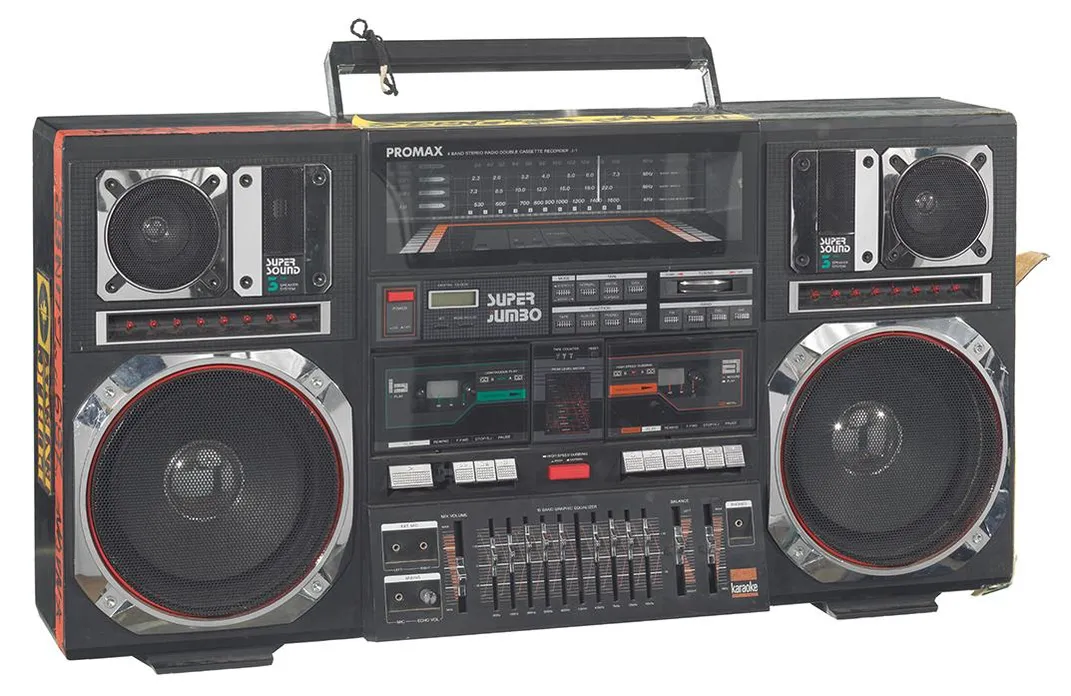The Ballad of the Boombox: What Public Enemy Tells Us About Hip-Hop, Race and Society
Thirty years after Public Enemy’s debut album, the group’s sonic innovation and powerful activism resonate powerfully today
/https://tf-cmsv2-smithsonianmag-media.s3.amazonaws.com/filer/d0/e0/d0e09666-9a81-44db-95c3-4cba599f057c/201314911001web.jpg)
When Timothy Anne Burnside spent a day in Atlanta with Chuck D in 2012, the last thing she expected was for the Public Enemy rapper to send her home with the group’s prized boombox. The band bought it in New York in 1987, the same year as they finished their first album, Yo! Bum Rush the Show. The boombox came on tour with the guys in the 1980s then again in the 2000s, providing music for their travels and acting as a stage prop during their shows. For Burnside, a curatorial museum specialist at the Smithsonian’s new National Museum of African American History and Culture, the boombox was an invaluable treasure.
It was also a cumbersome addition to her baggage on her flight out of Atlanta.
Delayed at security because she couldn’t check the boombox as luggage, Burnside was the last one to board her plane. She was also required to keep the newly acquired artifact within sight at all times, which meant the bags already stowed in the plane’s overhead compartments had to be shifted to make room for the boombox so that it was safely secured directly above her seat.
“Everyone hated me,” Burnside remembers of the experience years later. But that couldn’t diminish her joy over the acquisition. “That boombox is very special to me. We had quite the journey together.”
Now on display in the museum’s “Musical Crossroads” exhibition, the boombox is a striking symbol of the early years of hip-hop—and Burnside’s own experience with exploring music. She started her career at the Smithsonian processing jazz collections at the National Museum of American History. With its roots in jazz, funk and other early music styles, hip-hop was both part of a continuum and a singular moment.
“Thinking about how hip-hop was creating things that were brand new out of existing music was fascinating to me,” Burnside says. The sentiment was shared by many of the other curators working on the inaugural exhibitions at the new museum. “There was no battle to get hip-hop included, it was always part of the conversation.”
And Public Enemy is an absolutely crucial part of that conversation, says the museum’s Dwan Reece, curator of music and performing arts. “If you talk about albums that set a genre on a new course, Yo! Bum Rush the Show was the introduction to that new course.”
The album combined the vocal work of Chuck D (Carlton Ridenhour) and Flavor Flav (William Drayton) with drumbeats by Hank Shocklee and turntable riffs by Terminator X (Norman Rogers). The Bomb Squad, led by Shocklee, was the soon-to-be-famous production team that pulled the whole album together to create a distinct, multi-layered sound. When it was released by Def Jam Recordings (a label that included other notable artists like L.L. Cool J and The Beastie Boys) 30 years ago, on February 10, 1987, it permanently changed the course of hip-hop.
“The group did its rap homework well, because Public Enemy builds on some of the best ideas of earlier rappers,” wrote music critic Jon Pareles for his New York Times review. “At a time when most rappers typecast themselves as comedy acts or party bands, Public Enemy’s best moments promise something far more dangerous and subversive: realism.”
For Reece, hip-hip comes out of community and acts as a voice for people rebelling against their circumstances. The music, especially as created by Public Enemy, was in dialogue with the social and political issues of the day—of which there were many. “Despite all the advances that the Civil Rights Movement gave us, there was still poverty and disenfranchisement in our cities,” Reece says. For the members of Public Enemy, who met at college on Long Island, the city of their focus was New York.
Dramatic, violent clashes characterized New York City in the years leading up to the release of Yo! Bum Rush the Show. In September 1983, graffiti artist Michael Stewart was beaten and arrested by Manhattan police officers, leading to his death. In October 1984, an elderly and mentally disturbed woman named Eleanor Bumpers was shot to death by police officers attempting to evict her from her Bronx apartment. In December 1984, a white man named Bernhard Goetz shot four African-American teenagers on the subway after one of the boys approached Goetz for money. None died, but all were severely wounded. In his confession, Goetz said, “I wanted to kill those guys. I wanted to maim those guys. I wanted to make them suffer in every way I could… If I had more bullets, I would have shot them all again and again.” The jury found that Goetz acted in self-defense, guilty only of charges related to his possession of an unlicensed firearm.
And in December 1986, just two months before Public Enemy’s album was released, three young African-American men whose car had broken down were attacked by a gang of white teenagers in the predominately white, middle-class neighborhood of Howard Beach. One of them, Cedric Sandiford, was severely beaten by his assailants. Another, Michael Griffith, was beaten and chased into oncoming traffic on Belt Parkway, where he was hit by a cart and later died of his injuries.
All these deaths, and the rampant discrimination and economic disadvantages African-American communities faced, was the fuel on which Public Enemy propelled itself to fame. Through music, the group created a conversation.
“Chuck D used to say they were the black CNN,” Reece says. “They were really speaking out against issues like race and justice and inequality.”
In one song, “You’re Gonna Get Yours,” Chuck D references the cop calling him a punk during a traffic stop. “Pull me on a kick but, line up, times up/ This government needs a tune up/ I don’t even know what happenin’, what’s up/ Gun in my chest, I’m under arrest.”
In another, “Rightstarter (Message to a Black Man),” the lyrics go, “Some people think that we plan to fail/ Wonder why we go under or go to jail/ Some ask us why we act the way we act/ Without lookin’ how long they kept us back.”
“Hip-hop is activism and Public Enemy really embodies that ideal,” Burnside says. It’s an ideal that continues to resonate powerfully, even 30 years later. The issues Public Enemy tackled, like racism and police brutality, have been repeatedly forced into the public forum, with the deaths of Freddie Gray, Sandra Bland, Michael Brown, Trayvon Martin and others. Rallying to the cause, hip-hop artists from Janelle Monáe to Kendrick Lamar have dug into the issues in their work, much the same way Public Enemy did.
“Amidst everything that’s been going on in this country in recent years, there’s no denying the relevance of anything off their first albums,” Burnside says. “The message stands today and the sound stands today and it’s this amazing combination of sonic identity with a much larger, more resounding impact on popular culture and music.”
What better to represent such heavy ideas than a boombox? The boombox, as Burnside says, is a universal symbol for claiming your space. It was the portable music player before portable music players were also solely personal; unlike compact CD players or iPods, the boombox projects its music out to the world and stakes its territory. The same idea applies to Public Enemy, their use of sampling and their music itself.
“Public Enemy is in a place where it shouldn’t be, and so it’s a representation of black communities not belonging,” Burnside says. “Public Enemy and The Bomb Squad were not just inserting themselves into an existing sonic space, but creating a new one. At the time it was uncomfortable for many listeners, but it spoke to many communities who didn’t have a voice or hear their own voices.”
Public Enemy’s boombox as well as other performance pieces, such as costumes and banners can be viewed at the National Museum of African-American History and Culture.
/https://tf-cmsv2-smithsonianmag-media.s3.amazonaws.com/accounts/headshot/lorraine.png)







/https://tf-cmsv2-smithsonianmag-media.s3.amazonaws.com/accounts/headshot/lorraine.png)